Some Historical Information Sent to Me by Matt Sloan
"I grew up in the 1980s, and I had my first anemometer when I was
6 years old (1984). It was a Trade-Wind A-1. I had it for 4 years on the
roof and then I got a Heathkit weather station. However, over the years
I had several Trade-Winds: 3 A-2s, 1 double digital (RED), 4 A-1s, 1 DGREEN,
1 DGRED, and 3 of the oldest 110s. I have since tossed or given these away,
not knowing my BIG mistake at the time.
"I still have one of the 110s in somewhat decent shape (yes it works
OK), one of the oldest models with aluminum cups. I contacted Ron Tyler,
who used to make Trade-Winds, just recently about it and he was surprised
to hear that it still worked. It is aparently 30 some years old!
"For most owners sadly, Trade-Wind Instruments was a dissapointment.
Some of the earliest anemometers in the early 1970s made by them were actually
of fair quality, the first anemometers were the 110 and the 209sm. They
used aluminum cups with a Mabuchi M-36 hobby toycar motor with finger brushes
much better than the carbons in the future models, and plumbing fittings
painted with Krylon, and they lasted for some time. The outside anemometer
unit looks almost exactly like the plastic ones.
"By the mid/late 1970s they also were offering a four point wind
direction gauge with an aluminum vane. It was discontinued in the early
1980s in the interest of their digital gauges. In 1977 the first digital
unit was made, the DGRED. In addition, Trade-Wind switched to plastic cups
and and a new carbon brush motor. This design was used until they went out
of business completely in 1997.
"There were problems within the first few years with the anemometer
heads. The motor would freeze up on some, then there were others where the
cups would get blown off. Some of the units would hold together for years
and years and years and have no problems, mostly to inland owners. For those
at the coast, Trade-Winds were doomed. Some sensor heads would blow off
of the motor and mast, due to poor plastic bonding.
"I occasionally see a few around on roofs in the area, but they
are becoming the very few survivors, soon to be obsolete by nature. Most
owners would rather go out and buy a new Davis and throw out the Trade-Wind.
"I use my 110 only to go out and measure the biggest storms at Ecola
State Park. It is very fun! It's all I have left to remember my childhood
memories of big winds and Trade-Wind.
"I wish I could help more on obtaining some cup units, I just have
the 2 A-1 gauges and 1 old aluminum anemometer head that may quit soon.
I will see if I can come across some cups, I'll ask to buy them if I see
them on someone's roof sometimes. They sometimes work or sometimes not." |
Below, Trade-Winds Model A-1, with mph and knots
scales. |
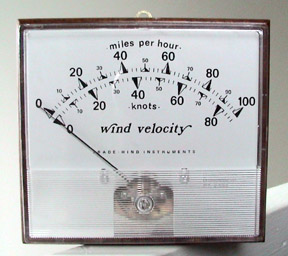
My own Experience With the Sensors
Matt Sloan's comments reminded me of some of the problems I encountered.
The first anemometer sensor lasted a fairly long time, about six years.
It was broken in that 55 mph Poctello windstorm mentioned above, when the
wind shoved a poorly anchored mast into a tree. That sensor was an "inland"
one, having been employed in the Renton area for most of that time. I had
three replacement sensors after that time up to 1996, and none of them lasted
longer than one to two years. The sensor in Martinez, CA, didn't make it
through one summer with 20 to occasionally 40 mph sea breezes fairly typical
each day, and I wonder if the persistent 100º+ heat didn't play a role
in killing the motor. One important thing that I liked about the systems
is that, with the exception of one single incident with the digital, the
anemometers appeared to have a good calibration, with readings generally
within a few mph of official stations, and usually "erring" on
the below side when there was a significant difference. |
| Below, Trade-Winds Model A-2, with dual scales, 0-30 mph and 0-120
mph. The top image shows the old-style face, and the bottom image shows
the new style. Other not-so-apparent changes include brass wall hangers
for the old A-2 and plastic for the new, and a rounded wood box face for
the old style with a squared-off wood box for the new. |
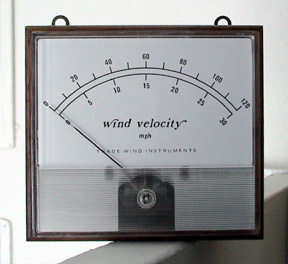
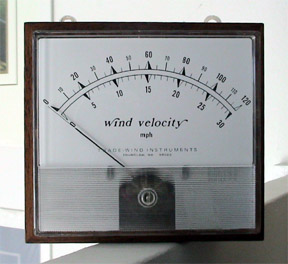
David Dombrowski's Long-Lived Sensor: 13 Years of Nor'Easters
"I have a Trade-Winds A-300 unit that I have had mounted on the
roof of my house since about 1990. Just recently (2003), the cup head stopped
turning. I live about 35 miles from the coast, halfway between Boston &
Cape Cod. Sixty-four miles per hour was the strongest gust I registered
for many years, until I got one that registered 84 mph during one bad storm.
The storm brought down one of my maple trees. We had "straight-line
winds" come through the area that did a lot of damage. The Trade-Winds
unit stayed put on top of my roof, though!" |
Sid Pierce on Trade-Winds Being the Local Entertainment
"The DGRED was a source of amusement in our small neighborhood on
Canoe Lake (Alaska) many years ago. On windy evenings, the neighbors would
drop by and we would all sit around and place bets on how high the wind
would register in a given time period. I guess you could say that it was
not only educational but amusing. It has served us well."
Sid obtained his DGRED system in the mid-1980s, and from what I understand,
it is still operational, even after registering a peak wind gust of 89 mph
in a past storm. In fact, a gale in March of 2003 with winds of 100 mph
clocked at the local airport failed to yank the cups from the roof (Sid
was away at the time). |
Additional Photos from Matt Sloan's Collection
Matt's friend Casey helped out with taking the photos, which depict the
history of Trade-Wind sensors. It's hard to tell them apart, for they're
all black (Matt recently repainted them), but pay close attention to the
cup spars. On the aluminum sensor, they spars are much narrower. |
| Below left, Trade-Winds Model A-1, with instruction booklet, lead
wire and aluminum cups. Below right, aluminum cups, which were sold
from 1971-1980. Note the narrow spars connecting the cups to the central
shaft. |
| Below left, Trade-Winds lexan cups, which were sold from 1977-1984.
Note thicker spars. Below right, polycarbonate cups, which were sold
from 1984-1997. Not very different looking than the lexan variety. |
|
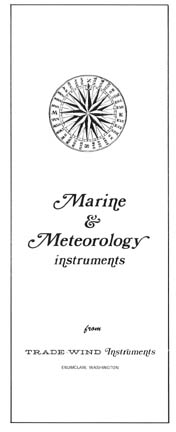 My first two anemometers
were made by a company in Enumclaw, WA, called Trade-Wind Instruments. The
front page of one of their last catalogs is shown to the left. They were
both good systems, and operated for years--decades, in fact. Recently, the
company has stopped making anemometers in favor of flow meters. This is
unfortunate, for I think they had a good product for a good price. Also,
the last of my sensor/generators (e.g. the "cups") died while
in use at Martinez, CA, back in 1996. The cups locked up during the height
of the Diablo Valley summer heat and strong, steady winds. Apparently, the
brushes on the electric motor failed. Now the gauges hang on my wall, sitting
idle, as reminders of past times. I got a lot of enjoyment out of the systems,
as the weather pages on this site probably show, and this page stands in
memory of a decent line of meteorological instruments, and some fun times
from my childhood.
My first two anemometers
were made by a company in Enumclaw, WA, called Trade-Wind Instruments. The
front page of one of their last catalogs is shown to the left. They were
both good systems, and operated for years--decades, in fact. Recently, the
company has stopped making anemometers in favor of flow meters. This is
unfortunate, for I think they had a good product for a good price. Also,
the last of my sensor/generators (e.g. the "cups") died while
in use at Martinez, CA, back in 1996. The cups locked up during the height
of the Diablo Valley summer heat and strong, steady winds. Apparently, the
brushes on the electric motor failed. Now the gauges hang on my wall, sitting
idle, as reminders of past times. I got a lot of enjoyment out of the systems,
as the weather pages on this site probably show, and this page stands in
memory of a decent line of meteorological instruments, and some fun times
from my childhood.
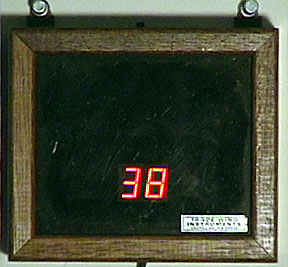
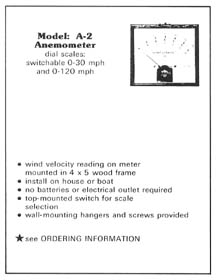 In the images
above, the anemometer gauge to the above left, and in the catalog description
to the immediate left, was my first one. Mine was and early version of the
Model A-2, which had a slightly different dial face than the catalog version.
Price was around $87.50. My dad bought it for me in the spring of 1982,
when I was 13. After watching the needle in a few storms and debating about
actual windspeeds, I quickly made the decision to pencil in every 1-mph
increment between the 20, 40, 60 (and 5, 10, 15) and so on that was printed
on the original dial. This system had a dual scale, 0-30 mph and 0-120 mph.
The 0-30 scale made for some interesting watching during a typical winter
storm at my home (15-30 mph gusts), and the 0-120 served for the bigger
windstorms, though the large range was a bit enthusiastic for the places
I lived--the highest gust I ever witnessed on this anemometer was 55 mph,
and that was during a springtime storm in 1988 at Pocatello, ID, a very
windy place indeed.
In the images
above, the anemometer gauge to the above left, and in the catalog description
to the immediate left, was my first one. Mine was and early version of the
Model A-2, which had a slightly different dial face than the catalog version.
Price was around $87.50. My dad bought it for me in the spring of 1982,
when I was 13. After watching the needle in a few storms and debating about
actual windspeeds, I quickly made the decision to pencil in every 1-mph
increment between the 20, 40, 60 (and 5, 10, 15) and so on that was printed
on the original dial. This system had a dual scale, 0-30 mph and 0-120 mph.
The 0-30 scale made for some interesting watching during a typical winter
storm at my home (15-30 mph gusts), and the 0-120 served for the bigger
windstorms, though the large range was a bit enthusiastic for the places
I lived--the highest gust I ever witnessed on this anemometer was 55 mph,
and that was during a springtime storm in 1988 at Pocatello, ID, a very
windy place indeed.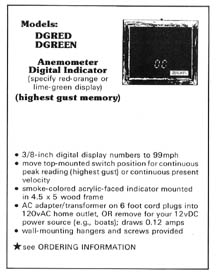 The anemometer to the upper right
was purchased in 1985. This model was the DGRED indicated in the catalog
description to the immediate right. It had a feature that the analog system
lacked: a peak gust register. All I had to do was flip the switch on the
top (which was similar to the dual-scale switch on the analog), and the
system would leave the highest wind recorded on the display. There was a
slight risk with this approach: if there was a power outage (unlike the
self-contained analog system, the digital required current from a wall plug),
and the peak gust register was on, then the anemometer would display a random
number between 0 and 99, potentially yielding a very large false reading.
This was a small glitch, and never made any problems for me. The beauty
with the digital was that it sampled at a rate far faster than most of the
ones on the market today--even the $1,000+ weather stations. Indeed, it
seemed to have near-instantaneous response to gusts, and then would hold
the final peak number attained a brief moment. If the wind pushed higher
during the "hold phase," the number would respond, insuring the
higher gust was not missed. For the price, which was about $132.50, this
ability was unprecedented for the time period.
The anemometer to the upper right
was purchased in 1985. This model was the DGRED indicated in the catalog
description to the immediate right. It had a feature that the analog system
lacked: a peak gust register. All I had to do was flip the switch on the
top (which was similar to the dual-scale switch on the analog), and the
system would leave the highest wind recorded on the display. There was a
slight risk with this approach: if there was a power outage (unlike the
self-contained analog system, the digital required current from a wall plug),
and the peak gust register was on, then the anemometer would display a random
number between 0 and 99, potentially yielding a very large false reading.
This was a small glitch, and never made any problems for me. The beauty
with the digital was that it sampled at a rate far faster than most of the
ones on the market today--even the $1,000+ weather stations. Indeed, it
seemed to have near-instantaneous response to gusts, and then would hold
the final peak number attained a brief moment. If the wind pushed higher
during the "hold phase," the number would respond, insuring the
higher gust was not missed. For the price, which was about $132.50, this
ability was unprecedented for the time period.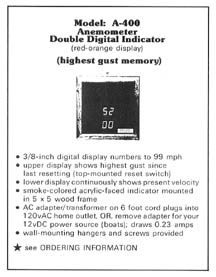 Trade-Wind Instruments also made a
dual-view digital that displayed the current windspeed along with the highest
gust. This system is depicted in the catalog description to the left. With
the single view on the digital I had, having the peak gust register on meant
missing all lower windspeeds, so I had my eye on purchasing the $234.50
dual-scale at some point. Life intervened, and I never obtained one before
Trade-Wind Instruments ended production of anemometers.
Trade-Wind Instruments also made a
dual-view digital that displayed the current windspeed along with the highest
gust. This system is depicted in the catalog description to the left. With
the single view on the digital I had, having the peak gust register on meant
missing all lower windspeeds, so I had my eye on purchasing the $234.50
dual-scale at some point. Life intervened, and I never obtained one before
Trade-Wind Instruments ended production of anemometers.
